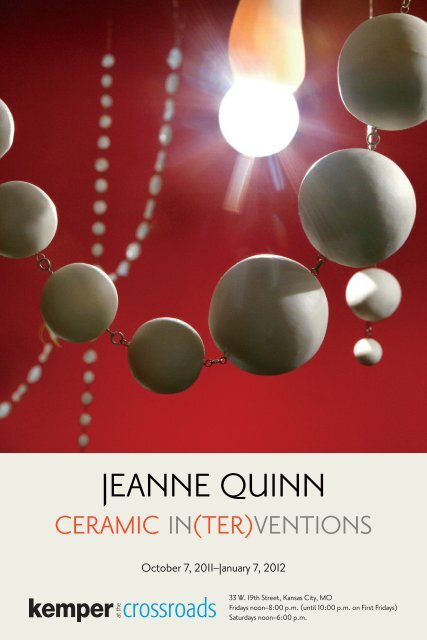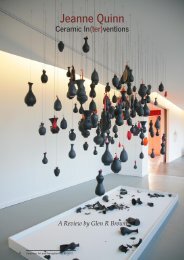view show brochure - Jeanne Quinn
view show brochure - Jeanne Quinn
view show brochure - Jeanne Quinn
Create successful ePaper yourself
Turn your PDF publications into a flip-book with our unique Google optimized e-Paper software.
JEANNE QUINN<br />
CERAMIC IN(TER)VENTIONS<br />
October 7, 2011–January 7, 2012<br />
33 W. 19th Street, Kansas City, MO<br />
Fridays noon–8:00 p.m. (until 10:00 p.m. on First Fridays)<br />
Saturdays noon–6:00 p.m.
Everything Is Not As It Seems (2009)<br />
The<br />
Question<br />
of<br />
Touch<br />
The relationship between the functional and the sensual reflects one of the central tensions<br />
in the sculptural installations of artist <strong>Jeanne</strong> <strong>Quinn</strong>. “When you are trained as a ceramicist,<br />
one of the things that you always think about is the relationship of the object to the body,<br />
because everybody, myself included, starts off making things for use. You start off making cups<br />
and bowls and plates, and so you’re asked to think about the handle and the lip, and how it is<br />
going to feel when you put this lip up to your lips, and you have this very intimate experience with<br />
the object.”*<br />
It was the field of architecture, particularly the work of Robert Venturi, Denise Scott Brown,<br />
and Steven Izenour, that introduced the vocabulary (visual and theoretical) of postmodernism<br />
to the visual arts. In short, they declared that symbols and iconography from the everyday vernacular<br />
could coexist with the historic monumental in the aesthetic realm. A signature element<br />
of postmodernism is the addition of a decorative element from one time period to a functional<br />
element from another: a self-conscious hybridizing of ideas, historic time frames, and an upending<br />
of the primacy of a discrete style. In Entrances (1977), Venturi sketches a baker’s dozen<br />
façades featuring styles borrowed from Egyptian temples, tidy Craftsman-style eaves, and the<br />
drawbridge gate from a medieval castle, often combined with tongue-in-cheek aplomb. In a<br />
column detail of the Allen Memorial Art Museum building at Oberlin College in Ohio, Robert<br />
Venturi, Rauch and Scott Brown (currently known as Venturi, Scott Brown and Associates) transforms<br />
the scroll-shape ornaments on the capital of an Ionic column into a double round, almost<br />
Pop art caricature of a thought balloon.<br />
A Thousand Tiny Deaths (2009) by <strong>Jeanne</strong> <strong>Quinn</strong> adopts the insouciant hybridity of postmodernism.<br />
Red, orange, and pink balloons, in every state of buoyancy and flaccidness, emerge from
the lips of black porcelain vessels, some classically shaped with handles and base; others with<br />
sleek modern profiles, elegant in their lack of ornamentation. The forms with handles seem to<br />
reference Roman amphorae, functional pots used to store and ship goods of all sorts.<br />
The title A Thousand Tiny Deaths has several compelling implications. In French, la petite mort<br />
is an idiom for orgasm, and the connection to waiting for a moment of release offers a plausible<br />
understanding of the work’s physical presence: the porcelain<br />
vessels appear to be suspended from a ceiling support<br />
using simple, black string. But a closer look reveals that it<br />
is the balloons, not the objects, that are held aloft. As the<br />
air (once the breath of the artist) slowly leaves the balloon,<br />
the vessel falls to the ground, crashing into countless<br />
small parts. Longevity, codependency, and the<br />
physics of gravity are all at play.<br />
Another possible implication of the title has a literary<br />
reference and offers a complicated metaphor, to be sure.<br />
In common parlance one might say, “A coward dies a<br />
thousand deaths, a hero but one.” In Shakespeare’s Julius<br />
Caesar, Act 2, Scene 2, Caesar tries, as he wakes, to determine<br />
the meaning of signs offered by the celestial<br />
world the night prior. Calpurnia, the last of Caesar’s wives,<br />
grapples with the events, as she states,<br />
When beggars die, there are no comets seen;<br />
The heavens themselves blaze forth the death of princes.<br />
To which Caesar, in convincing himself not to go to the<br />
Senate that day, says:<br />
Cowards die many times before their deaths;<br />
The valiant never taste of death but once.<br />
Of all the wonders that I yet have heard,<br />
It seems to me most strange that men should fear;<br />
Seeing that death, a necessary end,<br />
Will come when it will come.<br />
A Thousand Tiny Deaths (detail), (2009)<br />
Caesar is, of course, persuaded by his colleague Brutus<br />
(yes, of “Et tu, Brute?”) to ignore his instincts and attend<br />
the Senate that fateful ides of March. How might Caesar’s<br />
belief in “death, a necessary end” impact our metaphoric<br />
Ironic Column, courtesy of Venturi, Scott Brown and Associates,<br />
reading of the beauty, worth, and value of the vessels Inc., Allen Memorial Art Museum, Oberlin College, 1976<br />
about to crash to earth in A Thousand Tiny Deaths?<br />
The intimacy of cup to lips is translated into an extravagant, immersive experience in Everything<br />
Is Not As It Seems (2009). In this full gallery installation the Baroque meets the Now in a glowing<br />
field—garlands of white porcelain pearls draped from just skimming the floor to many feet above<br />
our heads, and bare light bulbs in a gallery painted red; the color of hearts, of flowers, of the
inner workings of the human body. The<br />
idea of a chandelier is very much present<br />
and was one of the artist’s inspirations.<br />
The structure of this work is deceptive,<br />
and what appears upon first approach to<br />
be a random composition is revealed as<br />
one walks between its two “halves” to<br />
be a bilateral symmetry based upon the<br />
skeletal form of the human body. One<br />
must enter the work to have this understanding.<br />
<strong>Quinn</strong>’s formal and conceptual conversation<br />
always circles back to the<br />
human body. In Rorschach Curtain<br />
(2006), each of the more-than-onehundred<br />
tiny porcelain elements is held<br />
a few inches from the wall with straight<br />
pins. The pins are from two traditions—<br />
those of the jeweler and the dressmaker:<br />
adornment and function again in conversation.<br />
The gallery lighting creates shad-<br />
Everything Is Not As It Seems (detail), (2009)<br />
owy doppelganger forms that in their deep gray have as much formal weight as the objects<br />
themselves. Unlike the other works on <strong>view</strong>, this one takes the scale and implications of a painting.<br />
The wall is painted three colors using a template, so as to be replicable. Because of the scale, it<br />
is possible to perceive the work at once. It operates differently from the installations, whose readings<br />
benefit from the <strong>view</strong>er moving around or through the work. Tiny ceramic moments, the gesture<br />
of the hand forming the shape of an active memory, are impaled by dressmaker pins through<br />
small Nichrome wire rings—a wire that can take the high heat of a kiln—and held to the wall in a<br />
complicated but ultimately symmetrical composition. The overall pattern, by virtue of its title,<br />
references the famous psychological barometer, where patients are <strong>show</strong>n inkblot patterns and<br />
asked to tell the psychiatrist what they “see.” The overall composition might remind one of a<br />
skeletal structure. The forms I see are direct references to bones of the body: long, slender femurs;<br />
the female pelvis; the hyoid (lingual) bone—that unique bone in the throat that allows for complex<br />
and varied speech in humans. Some of the objects take on an ominous tone: a pair of limbs spread<br />
in a position of vulnerability; long bones with connecting cartilage exposed.<br />
In <strong>Jeanne</strong> <strong>Quinn</strong>: Ceramic In(ter)ventions, the works of art may take center stage, but the <strong>view</strong>er<br />
becomes the central protagonist. A postmodern narrative arc allows for the juxtaposition of<br />
diverse elements; art history meets memory; the ephemeral meets the (seemingly) permanent;<br />
intimacy meets immersive experience. These dialogues, activated by the works of art, lead to<br />
new cultural meaning and individual understanding. The afterglow of looking at the bare light<br />
bulbs in Everything Is Not As It Seems is an apt metaphor for the way in which the experience of<br />
<strong>Jeanne</strong> <strong>Quinn</strong>’s art continues as part of our memories, both physical and experiential.<br />
—Barbara O’Brien, Chief Curator, Kemper Museum of Contemporary Art<br />
*<strong>Quinn</strong> quote from a studio conversation with the author, April 31, 2011.
<strong>Jeanne</strong> <strong>Quinn</strong> Biography<br />
The surprising, hybrid installations created by<br />
ceramic artist <strong>Jeanne</strong> <strong>Quinn</strong> engage the<br />
senses in a multitude of ways, as the artist explores<br />
the history of decorative objects and<br />
their relationship to the human body.<br />
Over the past 15 years, <strong>Quinn</strong> has exhibited<br />
extensively throughout the United States<br />
and Europe. She has had solo exhibitions at<br />
Jane Hartsook Gallery at Greenwich House,<br />
New York, New York; LUX Center for the<br />
Arts in Lincoln, Nebraska; John Michael<br />
Kohler Arts Center in Sheboygan, Wisconsin;<br />
and Formargruppen Gallery, Malmö, Sweden.<br />
Her work has been included in group exhibitions<br />
at the Denver Art Museum;<br />
Museum of Contemporary Art, Denver; the<br />
Museum of International Ceramic Art—<br />
Grimmerhus, Denmark; Skulpturens Hus,<br />
Stockholm, Sweden; and the Yingge Ceramics<br />
Museum, Taipei, Taiwan. <strong>Quinn</strong> has been<br />
awarded numerous residencies, most recently<br />
by the European Ceramic Work Center<br />
in s’Hertogenbosch, The Netherlands.<br />
<strong>Jeanne</strong> <strong>Quinn</strong> was born in Lemoore, California,<br />
and received her BA cum laude in art<br />
history from Oberlin College in Ohio in<br />
1988, and her MFA from the University of<br />
Washington in Seattle in 1995. <strong>Quinn</strong> currently<br />
resides in Boulder, Colorado, where<br />
she is Associate Professor and Associate<br />
Chair for Graduate Studies in the Department<br />
of Art and Art History at the University<br />
of Colorado.<br />
A Thousand Tiny Deaths (2009)
Above and detail below: Rorschach Curtain (2006)<br />
Works in the Exhibition<br />
Height precedes width precedes depth.<br />
Rorschach Curtain, 2006<br />
porcelain, wire, pins, paint<br />
38 1 ⁄2 x 51 1 ⁄2 x 3 inches<br />
Collection of Patricia Ammann,<br />
Boulder, Colorado<br />
Everything Is Not As It Seems, 2009<br />
porcelain, wire, paint, electrical hardware<br />
site-dependent installation,<br />
138 x 204 x 288 inches<br />
Courtesy of the artist<br />
A Thousand Tiny Deaths, 2009<br />
black porcelain, balloons, string<br />
site-dependent installation,<br />
129 x 72 x 144 inches<br />
Courtesy of the artist<br />
Thank you<br />
Generous support for Kemper Museum<br />
exhibitions is provided by Museum members;<br />
Missouri Arts Council, a state<br />
agency; Arvin Gottlieb Charitable Foundation,<br />
UMB Bank, n.a., Trustee; Francis<br />
Family Foundation; Richard J. Stern Foundation<br />
for the Arts, Commerce Bank,<br />
Trustee; David Woods Kemper Memorial<br />
Foundation; ArtsKC Fund—Arts Council<br />
of Metropolitan Kansas City; DST Systems,<br />
Inc.; Sosland Foundation; and Frontier<br />
Airlines.<br />
4420 Warwick Boulevard, Kansas City, MO 64111<br />
www.kemperart.org 816-753-5784<br />
image on cover: Everything Is Not As It Seems (detail), (2009); Installation photos: Bruce Mathews



